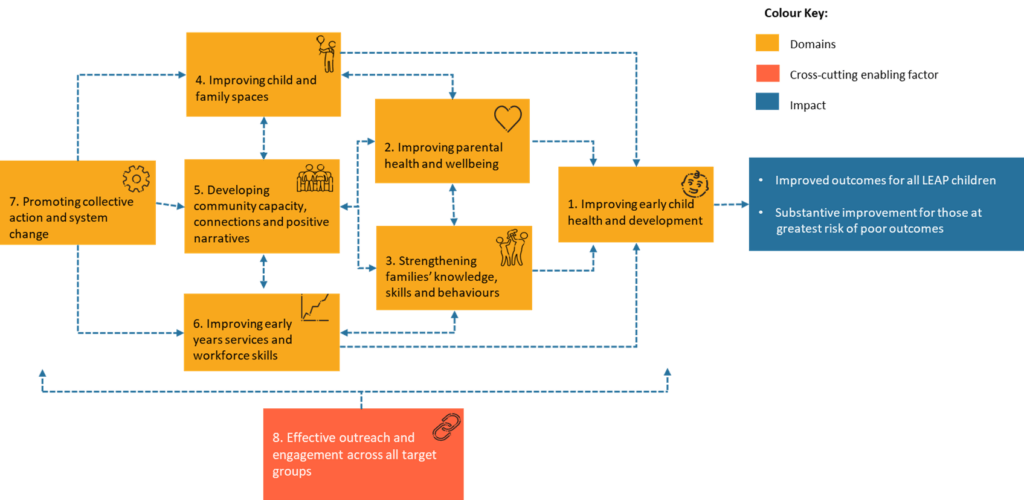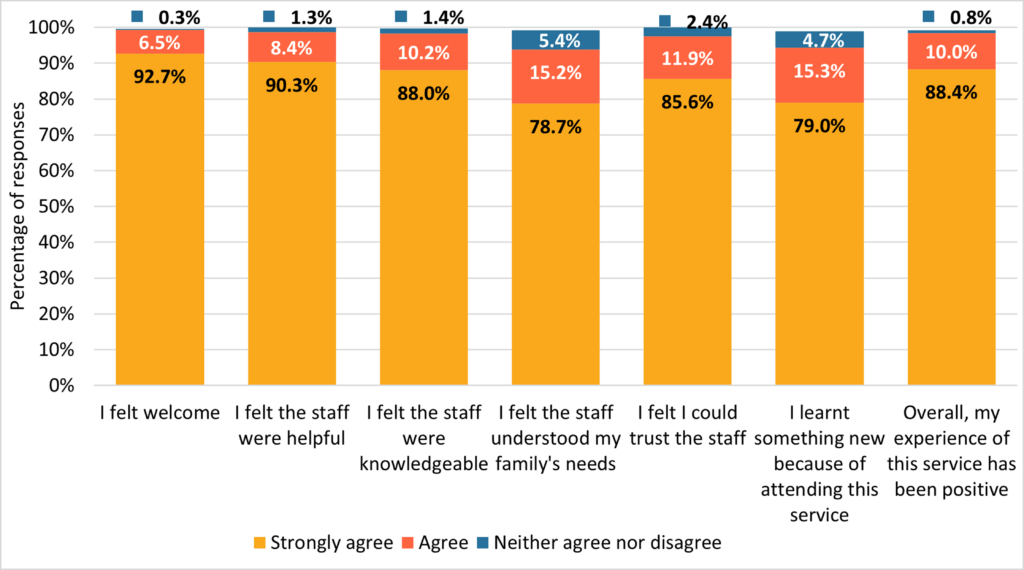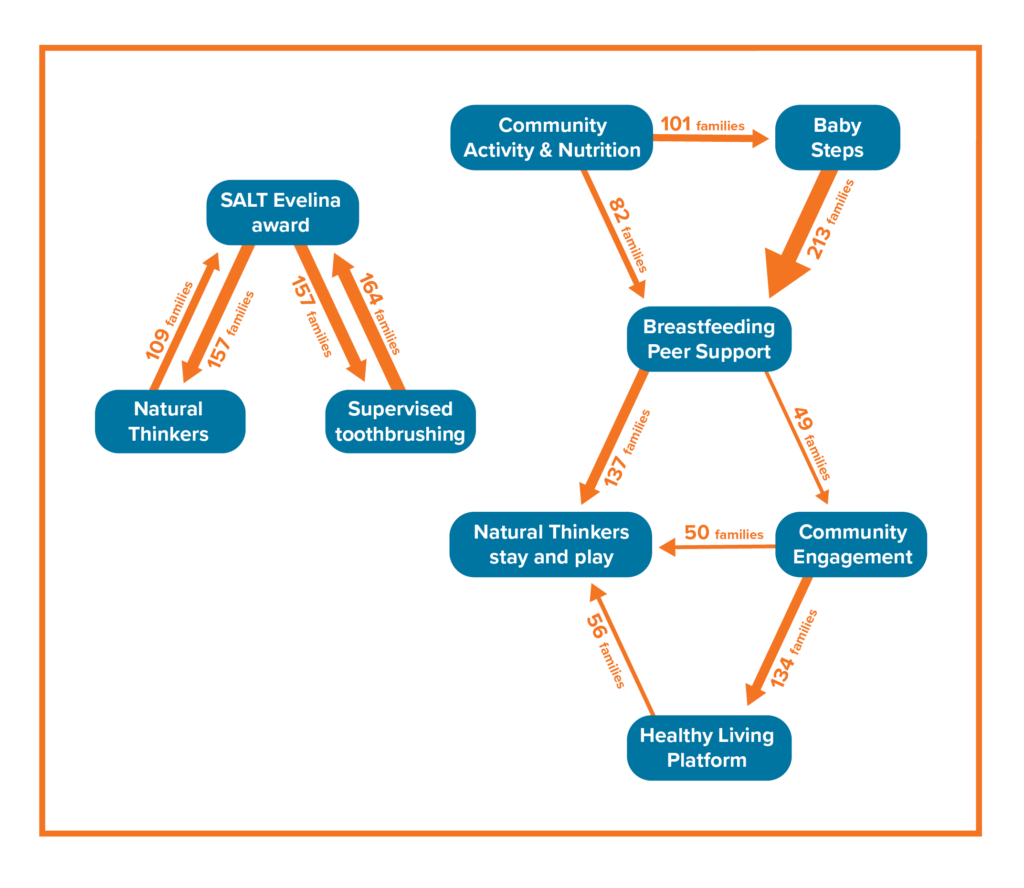Annual Learning Report 2022/2023 – Summary Report
Summary Report
Annual Learning Report 2022/2023
1.0 Message from Laura McFarlane, Director
I am excited to introduce LEAP’s second Annual Learning report.
One of the conversations I have often had with parents and carers is about the challenges of navigating the early years system. They have told me how difficult it can be to know what is available, when and where – particularly if you are new to an area, are a first-time parent, or you have English as an additional language.
Our second Annual Learning Report provides further understanding of the patterns of reach and engagement between families and LEAP services and builds on the insights in our first Annual learning report.
So, I am particularly proud that over the lifetime of the Programme, LEAP has reached a total of 15,374 families, including 14,028 children and 15,254 adults.
Overall, LEAP has engaged an estimated two thirds of the children under 5-years-old living in the areas of Lambeth where LEAP works.
Thousands of families have participated in the wide range of services and activities we have offered which help improve outcomes for very young children, and which support parents and carers. Of the 1,383 responses to LEAP’s Family Feedback Form, 93% ‘strongly agreed’ that LEAP services are welcoming.
Since 2015 LEAP has funded and supported more than twenty local services to meet the needs of families through pregnancy and the early years of childhood. Our LEAP programme is drawing to a planned close in September 2024. Most of LEAP’s services will continue to be provided by Lambeth Council and other partners, offering continuity for families.
Many people are involved in bringing the insights in this report together. From parents who complete questionnaires and feedback forms, to practitioners who regularly submit data. The LEAP Evaluation and Research Team have skilfully analysed and presented these findings.
I offer my thanks to all involved in this work.
I invite you to read this summary for an overview of the findings and then dive deeper into the full report for detailed analysis and examples.
Laura McFarlane
Director
2.0 About this report
This is the second of Lambeth Early Action Partnership’s (LEAP) Annual Learning Reports, which report on LEAP’s progress towards its intended aims. The first Annual Learning Report, published in March 2023 and including data from January 2015-April 2022 summarised evidence of LEAP’s progress towards improving Early Child Development outcomes. This report looks in more detail at LEAP’s approaches to engaging families and our reach within the local community.
The LEAP programme is now in its final year. This report will be complemented by a range of other evaluation outputs over the year including service evaluations and a summative evaluation delivered by an external research partner.
Authors: Rose Davidson, Dakota Langhals, Gemma Luck, Josefiina Valimaki, Claire Dunne, Herbie Hyndley.
With thanks to: The LEAP Core Team, LEAP service leads and practitioners, families who have participated in LEAP services or activities since 2015.
For more information about LEAP or this report, please contact leapadmin@ncb.org.uk.
3.0 Summary Report

3.1 About LEAP
Lambeth Early Action Partnership (LEAP) is one of five local partnerships which make up A Better Start (ABS), a national ten-year (2015-2025) test and learn programme funded by the National Lottery Community Fund that aims to improve the life chances of babies, very young children, and families. LEAP is supported by the National Children’s Bureau charity (NCB) and works with a wide range of families, practitioners, and organisations across Lambeth.
LEAP’s aim is to:
- Improve early child development outcomes for all children living in the LEAP area
- Reduce local inequalities by supporting those at greater risk of poor outcomes
LEAP operates in a focussed area of Lambeth which was selected based on local need, drawing on a range of local evidence that illustrated greater inequalities for young children in this area compared with the rest of Lambeth.
LEAP has funded and developed more than 20 local services to meet the needs of families through pregnancy and the early years of childhood. LEAP is a ‘collective impact initiative’, which means that all our services and activities link together and work towards shared goals to improve outcomes for very young children.
Definition: Collective impact
LEAP is a collective impact initiative which means that all our services and activities link together and work towards shared goals to improve outcomes for very young children.
3.2 About this research
Recent government research on the uptake of early education and childcare entitlements showed an overall decline in the uptake of free entitlements. In particular, it found that London had the lowest uptake rate of both the 3- and 4-year-old universal entitlement (84% uptake) and the targeted 2-year-old entitlement (61% uptake)1.
Participation in early years services is particularly beneficial for children facing disadvantages (for example, children from low-income families, children in care, disabled children and children with special educational needs) but uptake among these families is lower than average2.
If services do not effectively engage with families, there is a risk that the development and educational gap between children from better-off families and their disadvantaged peers may widen3.
Outreach and engagement with local families is a core aspect of the work of LEAP’s services and is represented in our programme Theory of Change (see Figure 1).

We define engagement as families’ interaction with LEAP services or activities.
LEAP’s engagement aims:
- Engage families, with children aged 0-3, and expectant parents, with LEAP activities and services
- Sustain family engagement with LEAP – for continued attendance of a service, and the uptake of multiple services
- Connect families to further provision and support outside of the LEAP offer
This research builds on the insights around LEAP’s engagement presented in the first Annual Learning Report which analysed data from January 2015-April 2022. We provide further understanding of the patterns of reach and engagement between families and LEAP services.
This research aims to:
- Document LEAP’s approach to engaging families
- Offer learning around our engagement in terms of who has and hasn’t engaged with LEAP
- Explore the patterns of engagement for different groups of families and services
- Offer some interpretation of patterns of engagement
- Generate questions for future evaluation and research activity
Unless otherwise stated, data included in this report was collected between 23 November 2015 and 31 October 2023.
3.3 Key findings
Over the lifetime of the programme LEAP has reached a total of 15,374 families including:
- 14,028 children
- 15,254 adults
LEAP has engaged an estimated two thirds of children under 5-years-old living in the LEAP area.4
LEAP has delivered 208 training sessions, seminars, or webinars to 1,807 early years practitioners working in Lambeth or neighbouring boroughs.

3.4 Engaging our priority population
LEAP’s priority population refers to families who live in the LEAP area who are from Black, Asian and Multiple Ethnic Groups and/or live in more deprived areas in Lambeth.
By defining and monitoring our engagement of a priority population across the programme we can assess whether services and activities have been accessible, welcoming, and appropriate for the local community.
Analysis of linked Health Visiting and LEAP engagement records found that 78.9% of children whose family participated in a LEAP service had characteristics consistent with LEAP’s priority population criteria. 77.1% of children whose family had no record of engagement with LEAP services had characteristics consistent with LEAP’s priority population criteria (see Figure 3).

Within the context of declining service uptake in Early Childhood Education and Care, LEAP has successfully engaged the local population. Engaged families are representative of our priority population.
3.5 Families living outside the LEAP area
There has been a high level of service usage by families living outside of the LEAP area (See Figure 2).
This might indicate an appetite for similar services more widely, but it also indicative of the nature of delivering a space-bound programme of activities when families’ lives transcend ward boundaries. On average, the families living outside of the LEAP area who are accessing LEAP services have lower levels of neighbourhood deprivation than LEAP area families, this suggests that they may have more resources and are able to travel to access services further from where they live.
However, families from outside the LEAP area generally engaged with fewer services and fewer sessions per service than families from the LEAP area. Families living outside the LEAP area made up 28% of attendances at service sessions, activities, or events, whereas families living inside the LEAP area made up 67% of attendances.
3.6 LEAP’s Community Engagement programme
LEAP’s Community Engagement programme has made a positive contribution to families’ engagement with LEAP. Community Engagement events and activities have acted as the front door to LEAP for over 1 in 10 (14.5%) of the families who have engaged with LEAP services.
Of these, 16.4% went on to access LEAP services. Families from LEAP’s priority population were 2.4 times as likely to continue engaging than families not from the priority population.
It is particularly encouraging to see that LEAP’s priority population has been well represented in this pathway, suggesting that Community Engagement events and activities have been appealing and accessible to the families we most wanted to reach.
Our data analysis shows that families who first engaged with a Community Engagement event or activity went on to be more highly-engaged participants in the LEAP programme, accessing a higher number of services as well as attending more sessions per individual service.

3.7 Families rated LEAP services and activities very highly
Feedback from families about LEAP services was extremely positive. In the majority of responses, respondents strongly agreed that LEAP services were welcoming (92.7%), and that LEAP staff were knowledgeable (88%), helpful (90.3%) and trustworthy (85.6%) (See Figure 5). In most responses, respondents said that they would highly recommend LEAP services and activities to their family or friends.

In qualitative feedback families commended the supportive and safe environment fostered within LEAP services and activities, the high quality of services and facilities and having the opportunity to connect with other families and services.
3.8 Families reported improved knowledge and confidence after attending LEAP services
Improvements in knowledge and confidence are key medium-term outcomes for the LEAP programme and indicate progress towards longer-term childhood development outcomes. They can also provide more insight into families’ experiences of services.
Analysis of medium-term outcome data showed that:
- LEAP’s parenting services helped parents and carers to feel more knowledgeable and confident about their parenting.
- LEAP’s CLD services increased parents’ and carers’ knowledge and confidence around supporting their child’s early communication, language and literacy development. Findings suggests that these services have been particularly beneficial to families with English as an additional language.
- LEAP’s Community Activity and Nutrition service helped parents and carers to feel more knowledgeable and confident about leading a healthy lifestyle.
3.9 Sustained engagement with LEAP services
Once they had engaged with a service or activity, LEAP aimed to sustain families’ engagement in two ways:
- Within a service, families repeatedly attend sessions.
- Within the wider LEAP programme, families go on to access other services.
Analysis of engagement data found that family retention in course-style services was good, with 67.2% of participants reaching a minimum required number of sessions to have benefited from the service and 35.6% completing the course.
22.5% of families access multiple LEAP services. This excludes families who only attend Community Engagement Events or Activities. This equates to 2,088 families engaging with at least two LEAP services at any point from the beginning of the programme up to October 31st 2023. The majority (77.5%) of families attended only one LEAP service, excluding Community Engagement events or activities. Just over 6% of families (573 families) engage with more than two services.
Families from LEAP’s priority population are more likely to engage with multiple services than families not from our priority population (See Figure 6).

When looking at links between services, we can analyse family engagement in terms of which services a family attended and when, or in which order they were accessed. Figure 7 highlights the most common combinations or pathways of services accessed by families who used two services.

The most common pathways in our network are those between services that are frequently delivered in the same locations:
In Figure 7, the left-hand collection of pathways shows strong links between Natural Thinkers, Speech and Language Evelina Award and Supervised Toothbrushing. These services are all based at and run through local early years settings. Many of these settings have implemented multiple LEAP services at the same time, meaning that children will likely engage with multiple services whilst spending time at the setting they are enrolled at.
Families are likely to benefit from and utilise a network of services that address broadly similar areas of need:
In Figure 7, the right-hand collection of pathways shows strong links between LEAP’s Community Activity and Nutrition (CAN), Baby Steps and Breastfeeding Peer Support. These services are all accessed by families during the perinatal period and work to refer and signpost families between each other as a pregnancy and baby develops.
Families are also more likely to access multiple of the universally available services:
In Figure 7, the right-hand network of pathways shows families frequently attending Community Engagement events or activities as well as the Healthy Living Platform. There is also a strong pathway between these two points and Natural Thinkers stay and play. All three of these services are universally accessible to local families and are more likely to be used by non-LEAP area families compared to LEAP’s targeted or specialist services.
3.10 Enablers and Barriers to family engagement
To build an understanding of some of the drivers of the patterns of family engagement with LEAP, we conducted qualitative interviews with core team members responsible for service management and delivery across the LEAP programme.
Interviews provided insights into:
- perceived factors challenging initial and sustained family engagement with LEAP services and activities; and
- approaches used across the programme to address these barriers and support family engagement
Five key themes were highlighted:
Raising awareness of LEAP: Local families need the right information delivered clearly to understand the services and activities that LEAP offers and how they can be accessed.
Outreach and recruitment capacity: Intentional outreach and person-centred recruitment supports the engagement of families, but service teams need ring-fenced time and capacity to do this.
Responsive and flexible provision: Families are more likely to keep engaging with services that are responsive and flexible to their feedback and needs.
Accessibility of services: services and activities should be delivered in local, accessible spaces to ensure all families can engage.
Trusting Relationships: Families are more likely to engage with services and teams who they feel they can trust to deliver high-quality, and safe provision.
3.11 Conclusions/recommendations
This report presents in-depth analysis of who has engaged with LEAP services and activities, and how families have engaged. As LEAP enters its final phase, we are pleased to have exceeded our early goal of reaching 10,000 local children.
Against the background of declining uptake of early years offers, the challenges of COVID-19 and the cost-of-living crisis as well as evidence that groups like LEAP’s priority population are least likely to access early years services, the extent of our reach, and the findings that those engaged are representative of our priority population is a significant achievement.
We are also pleased to show the specific contribution of our Community Engagement programme in both the initial and sustained engagement of local families, particularly those from our priority population. This report provides some evidence that working with communities in this way is a valuable and effective approach to supporting the uptake and continued engagement with services.
Families continue to rate LEAP services very highly, with feedback data being consistently positive.
LEAP services are set up to operate primarily within the LEAP area and to be welcoming and accessible to the local community. Feedback data, alongside the findings from engagement data, suggests that this approach has been successful.
Retention of families once engaged with a service was good. Over two thirds of course-style-service participants attend a minimum number of sessions to achieve dosage, where the service is expected to have made some impact, and over one third completed the course and will have been able to benefit fully from the service.
Medium term outcomes data illustrates that most parents felt services were supporting improvements in their knowledge and confidence around supporting their child’s early development.
As a collective impact initiative, it is encouraging to see that 1 in 4 families attended multiple LEAP services over the course of the programme. Analysis of multiple service use data revealed some strong links between particular groups of services.
The most common pathways suggest that families will be more likely to attend several services if they are delivered from the same setting, if they are universally accessible and if they cluster around a particular need with particularly strong pathways in perinatal services that offer support from pregnancy to the post-natal period.
More research could be done into the patterns of multiple service use, LEAP is unable to directly monitor referrals or signposting which could provide a much deeper understanding. However, these findings provide initial patterns of interest to anyone working in a collective impact, or place-based programme.
The themes highlighted throughout the report about the barriers and enablers to family engagement provide insight into the day-to-day approaches being used by LEAP to address these barriers, engage and keep families engaged with services.
Based on the other evidence presented here, we feel confident that these approaches have been working to support engagement with families and will provide valuable insight for programmes and service providers in other areas and contexts.